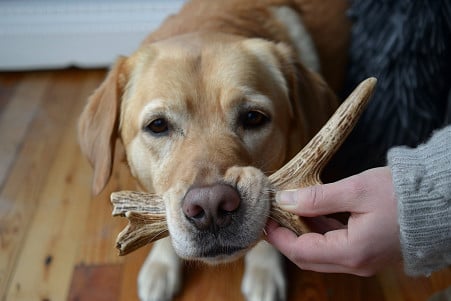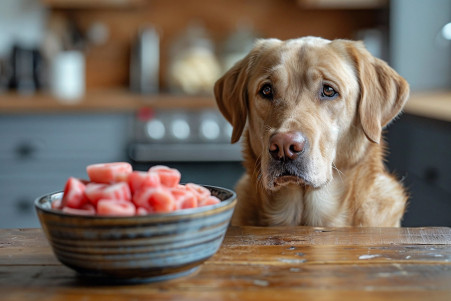Can Dogs Have Antlers? The Good and the Bad
25 April 2024 • Updated 25 April 2024

If you’re a dog owner, you may have heard about antlers as a natural alternative to other dog chews, but are they safe? Antlers are safe for most dogs to chew on as long as they are given under supervision. They are long-lasting, help keep teeth clean, and satisfy a dog's urge to chew. However, antlers can also cause tooth fractures and pose a risk of obstruction if dogs swallow small pieces, so they should be introduced with caution.
Although antlers can be a good chewing option for many dogs, we’ll look at veterinary research and animal behaviorist perspectives to help you understand the good and the bad of this type of dog chew. By exploring the benefits and drawbacks, we’ll help you decide if antlers are the right option for your dog.
Are antlers safe for dogs?
Safer Alternatives to Antlers
Veterinarians suggest that pet owners choose chew toys that have a little bit of “give” to them, and avoid very hard chew toys like antlers and bones that can lead to tooth fractures. According to Dog Lab, any chew toy that is harder than the surface of your fingernail can lead to tooth damage.
Safer alternatives to antlers include rubber chew toys like Goughnuts rings or the West Paw Hurley, nylon chew toys like the Nylabone Dura Chew, and durable rubber Kong Extreme toys. Other good options include bully sticks, beef chews, and rawhide-free chews made from plant-based materials like sweet potatoes or animal-derived options like turkey tendons.
When choosing a chew toy, it’s important to consider the strength of your dog’s chewing habits and the strength of the toy. For example, very powerful chewers may need a toy as strong as Goughnuts, while more moderate chewers can use a less durable option. It’s also important to rotate your dog’s toys regularly to keep them interested and to prevent them from chewing on a toy to the point that it becomes a safety hazard.
How to Introduce New Chew Toys
When you're introducing new chew toys, it's important to do so gradually over the course of 5 days, with initial chew sessions lasting 3-5 minutes. You can then follow the guidelines from Natural Farm Pet to increase the length of the sessions as your dog gets used to the new toy. Make sure to offer water and keep a close eye on your dog to make sure the introduction of new chews goes smoothly.
Don't give your dog rawhide treats, which can be a choking hazard, and instead give them safer rawhide alternatives like bully sticks or beef chews. Make sure to pick chews based on your dog's size and chewing style to prevent potential injuries, according to Preventive Vet. Introducing and monitoring your dog are the most important things to keep in mind when trying new chew toys.
How to Safely Monitor Your Dog With Chew Toys
Because every dog is different, there are no hard and fast rules for dog toy safety. However, understanding your dog's toy preferences and habits can help you make safer choices and understand when close monitoring is necessary, according to Monster K9.
While natural rubber toys are generally safe, they should still be monitored. The Humane Society recommends checking toys regularly for small pieces that could pose a choking hazard and replacing any toys that are worn or damaged.
Toys with stuffing, squeakers, and especially tasty chews all require close supervision to ensure that dogs don't consume them too quickly. According to All Dogs Gym, these toys can be especially dangerous if a dog manages to remove and swallow the squeaker or other small pieces. Monitoring your dog's chewing habits and adjusting the type and firmness of chews they receive can also help prevent dental problems.
Safe Chewing Times for Antlers
As reported by Pet Expertise, large dogs can chew on deer antlers for up to 30 minutes a day, while puppies under 6 months of age should be limited to 15 minutes or less. All-day or multi-hour chewing sessions can lead to choking and dental hazards, especially for dogs with sensitive teeth. As Best Bully Sticks explains, antlers are extremely hard and can cause dental fractures and other oral health issues when chewed aggressively or for long periods of time.
Therefore, when it comes to giving dogs deer antlers as chews, it's important to do so in moderation and to limit the amount of time they spend chewing on them. According to Pet Expertise, the average life of an antler chew can range from six months to a year depending on the size, hardness, and how aggressively the dog chews. It's also important to keep an eye on the size of the antler and remove small pieces to prevent choking hazards.
Antlers and Dogs: Wrapping Up the Discussion on Safety and Use
While chewing is a natural and healthy dog behavior, the wrong chews can lead to dental problems. For example, very hard chews such as antlers can cause tooth fractures, gum damage, and other dental issues. Safer options like rubber, nylon, and edible chews can help dogs get the benefits of chewing without the risk of dental damage.
Regular dental exams and cleanings can help ensure that any dental problems caused by chewing are caught and treated early. It's best to talk to a vet to get personalized advice on the safest chew toys for your dog based on their age, breed, and chewing style.


